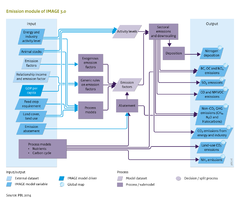Emissions/Description: Difference between revisions
Jump to navigation
Jump to search
No edit summary |
No edit summary |
||
| Line 2: | Line 2: | ||
|Reference=IPCC, 2006; Cofala et al., 2002; Stern, 2003; Smith et al., 2005; Van Ruijven et al., 2008; Carson, 2010; Smith et al., 2011; Bouwman et al., 1993; Velders et al., 2009; Kreileman and Bouwman, 1994; Bouwman et al., 1997; Bouwman et al., 2002a; | |Reference=IPCC, 2006; Cofala et al., 2002; Stern, 2003; Smith et al., 2005; Van Ruijven et al., 2008; Carson, 2010; Smith et al., 2011; Bouwman et al., 1993; Velders et al., 2009; Kreileman and Bouwman, 1994; Bouwman et al., 1997; Bouwman et al., 2002a; | ||
|Description===General approaches== | |Description===General approaches== | ||
The table on [[Emissions | The table on [[Emissions#Inputs|the introduction page]] lists the different sources of emissions included in the IMAGE model. Emissions that are transported in water (nitrate, phosphorus) are discussed in [[Nutrient balances]]. Regarding the approach and spatial detail for modeling gaseous emissions, IMAGE uses four different ways to represent emissions. | ||
* ''World number'' (WRLD). The simplest way to estimate emissions in IMAGE is by using a global estimate from the literature. This approach is used for those natural sources that can not be explicitly modelled. | * ''World number'' (WRLD). The simplest way to estimate emissions in IMAGE is by using a global estimate from the literature. This approach is used for those natural sources that can not be explicitly modelled. | ||
* ''Emission factor method'' (EF). For other sources in IMAGE, past and future developments in anthropogenic emissions are estimated on the basis of projected changes in relevant economic activities and the emissions per unit of activity (emission factor) (see flowchart on the right). | * ''Emission factor method'' (EF). For other sources in IMAGE, past and future developments in anthropogenic emissions are estimated on the basis of projected changes in relevant economic activities and the emissions per unit of activity (emission factor) (see flowchart on the right). | ||
Revision as of 15:24, 15 January 2014
Parts of Emissions/Description
| Component is implemented in: |
Components:and
|
| Projects/Applications |
| Models/Databases |
| Key publications |
| References |
|
